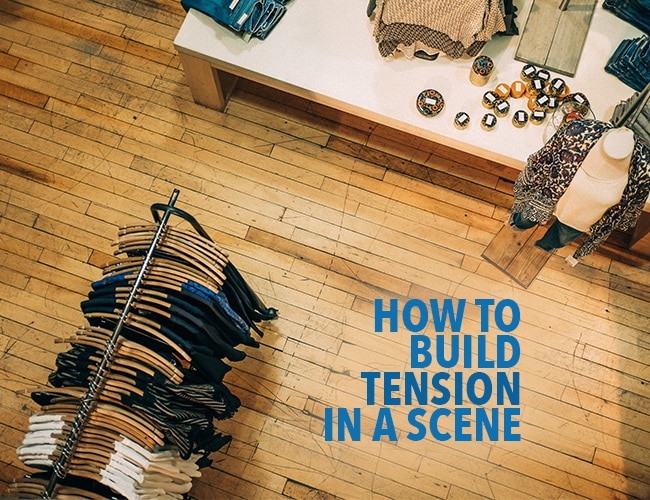Great fiction is built around tension. The bad news is, we experience tension in our own lives every day. The good news is, it's great fuel for our stories. So how do you create that experience for your readers by building tension in your scenes?

Now that the holidays are over, chances are good that you've had to make a return. Whether it was a sweater in the wrong size or a gadget you already owned, returns and exchanges are a regular part of post-holiday stress. If you've ever worked in retail, you've experienced the extended hours, disgruntled shoppers, and high tensions all around.
Returns can escalate that tension. Sounds like perfect inspiration for fiction.
The Tension of Retail
In college, I worked full-time in a clothing store. Holidays were busy, requiring longer hours, more inventory turnover, and additional customer service. While the fast pace often made the time pass quickly, the constant demands created a tense environment on many days. Even once the major event passed, there was still the matter of clean up, markdowns, and returns.
So many returns.
And so many stories about why an item needed to be returned, why there wasn’t a receipt, and why they needed me to make an exception to our policy for them. All while people in the growing line fidgeted, sighed, or became belligerent.
You’ve probably been witness to a scene like this one, too. I thought it might make a great prompt to practice writing tension.
3 Tools to Maximize Tension
Tension is caused when something is stretched tight, when there are opposing forces pulling in opposite directions. To create tension in our scenes, we can use three elements found in any store return: opposing goals, stakes, and time.
1. Opposing Goals
In a retail return, ideally the opposing goals are minimized by the return policy. The business wants to make money or minimize loss. The customer wants to get an item they want or their money back. Those goals don’t have to be in conflict, but they often are, especially when one party feels strongly about what they are owed.
I once had a woman trying to return a pair of shoes. We didn’t sell shoes. She insisted she’d bought them from us, demanded the manager (I was the manager), and left in a huff shouting that she’d never shop with us again.
Think about a book or film you’ve watched recently and see if you can’t find characters with opposing goals. They are almost always present: the parents who want one life for their daughter while she pursues another, the detective trying to uncover the truth a murderer is trying to hide, or the man who falls in love with his best friend while she pursues someone else. Opposing goals.
2. Stakes
This might go without saying, but if the opposing goals don’t matter to the characters, then the tension is lost. To increase the tension, raise the stakes.
In my literature classes, students often ask why so much of what we read seems to be about death. An insightful student observed, “Because isn’t that the point? We’re all trying to avoid death.”
He was right, but stakes don’t have to be life or death. The stakes need to be something the character deeply cares about. The challenge is helping the reader understand why those stakes are so important.
If my attempted shoe return had been a scene in a story, I would need to establish why receiving a cash refund for those shoes was worth a public spectacle to this woman. Why this store? Why these shoes?
If she’s trying to win a bet, those are different stakes than if she’s trying to feed a family. Decide which stakes are right for your story and character.
3. Time
Finally, the manipulation of time can increase tension. Sometimes tension is caused by having a deadline, like a bomb counting down, the characters racing against the clock. Keeping two potential lovers at odds over time creates tension.
Or you can make people wait for someone else, as in our retail example, where the protracted time is inefficient and irritating.
Consider the role time will play in escalating the tension in your story, and use it to build suspense or conflict.
The Tension of a Good Story
Many of my retail experiences were, in fact, pretty minor. They felt intense in the moment, and they even make fun anecdotes to tell at parties. But the stakes were too low, or the goals were too similar, or the time pressures were too mild for me to write an entire novel based off of one encounter.
Your challenge as a writer is to take these three tools for how to build tension in a scene and use them to create scenes where your characters—and by extension, your readers—must face tension.
Then again, you might be surprised at the variety of ways people experienced these tensions when standing in line for returns. Could you turn a retail experience into a novel?
When have you noticed tension in real life? What elements contributed to the tension? Share in the comments.
PRACTICE
Take fifteen minutes to create a scene that builds tension. If you’d like, write a return scene, with your character as the clerk or customer. Focus especially on escalating the tension through goals, stakes, and time.
When you're done, share your practice in the comments and encourage another writer today!
Sue Weems is a writer, teacher, and traveler with an advanced degree in (mostly fictional) revenge. When she’s not rationalizing her love for parentheses (and dramatic asides), she follows a sailor around the globe with their four children, two dogs, and an impossibly tall stack of books to read. You can read more of her writing tips on her website.
0 Comments